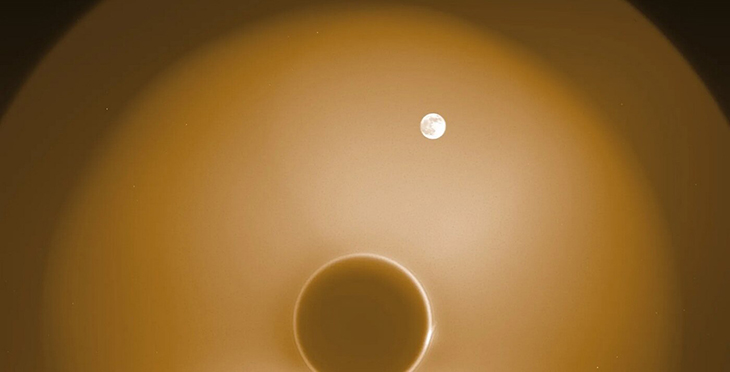

A Rare View from Space: Earth’s Moon and the Sun in Harmony
A breathtaking new image released by NASA offers a mesmerizing look at the Sun and Moon, captured not from Earth, but from deep space. The photograph—depicting a luminous halo of light surrounding a partially eclipsed Sun with the Moon elegantly moving across it—was taken by a relatively unknown NASA mission named PUNCH (Polarimeter to Unify the Corona and Heliosphere). This captivating visual emerged during the mission’s commissioning phase, a crucial stage where instruments are tested and aligned before full operation begins.
The image is not only visually arresting, but also scientifically rich. The Moon appears subtly illuminated—not from the Sun, but by sunlight reflected off Earth, creating a soft glow rarely seen in space-based images. More than an artistic spectacle, this moment underscores the precision of PUNCH’s instruments, which are designed to probe some of the most elusive phenomena in our solar system.
The Mission Behind the Magic: What Is PUNCH?
Launched on March 11, 2025, PUNCH consists of four suitcase-sized satellites working in tandem to study one of the most dynamic elements of our solar system: the solar wind. These small satellites are equipped with an instrument known as an occulter—a device that blocks out the bright central disk of the Sun, allowing the surrounding solar corona to be imaged in remarkable detail.
This imaging technique, which mimics a total solar eclipse, allows PUNCH to capture features otherwise lost in the Sun’s blinding glare. The golden halo seen in the photo is actually sunlight reflecting off the front surface of the occulter, while the fainter wisps encircling the darkened Sun represent the Sun’s corona—its ultra-hot outer atmosphere. The corona is where the solar wind originates, making it a crucial target for understanding solar behavior.
Unlocking the Mysteries of the Solar Wind
Solar wind is a constant stream of charged particles that the Sun emits into the solar system at speeds of up to 1.6 million kilometers per hour. Every second, the Sun ejects approximately 300,000 tons (272,000 metric tons) of this material, forming a solar breeze that shapes the entire heliosphere—the vast bubble surrounding our solar system.
While the solar wind can create awe-inspiring effects like the auroras, it also poses risks to satellites, astronauts, and even power grids on Earth. High-energy solar storms, carried by gusts in this wind, can disrupt communications, navigation systems, and electrical infrastructure. Understanding and predicting such events has become a scientific and geopolitical imperative.
According to PUNCH’s principal investigator, Craig DeForest, the mission aims to bridge the gap between two fields of heliophysics: space-based sampling and solar imaging. “PSP [Parker Solar Probe] is carrying the techniques of space physics (in-situ sampling) inward to touch and measure the solar corona. PUNCH is extending the techniques of solar physics (scientific imaging) outward to measure how the solar corona touches us. The two missions complement each other beautifully,” DeForest told Live Science via email.
A Team Effort: PUNCH and the Parker Solar Probe
PUNCH is not alone in its quest. It works in concert with NASA’s more renowned Parker Solar Probe (PSP), which in 2021 became the first human-made object to plunge into the Sun’s corona and exit unscathed. Whereas PSP collects direct particle samples and data from within the Sun’s outer atmosphere, PUNCH provides a macro-scale visual context for those interactions. Together, they form a powerful duo for decoding solar activity.
By combining their capabilities, scientists hope to track plasma streams, magnetic loops, and coronal mass ejections (CMEs) from their point of origin on the Sun to their potential impact zones on Earth. This level of predictive capability would be a game-changer in what experts call “space weather forecasting”—a field that could help countries anticipate and mitigate disruptions from solar storms.
Why It Matters: Science, Security, and the Future
As our world becomes increasingly reliant on satellites and electronic infrastructure, the importance of understanding and forecasting solar weather continues to grow. In an age of climate uncertainty, geopolitical fragility, and technological vulnerability, NASA’s investment in heliophysics missions like PUNCH represents a forward-looking strategy rooted in scientific resilience.
Moreover, the beauty of the image captured during PUNCH’s commissioning phase is a powerful reminder of how science and art often intersect. It encapsulates both the mystery and the majesty of space—while quietly underpinning the immense engineering and scientific effort driving modern space exploration.
With missions like PUNCH and PSP working in tandem, humanity is not only getting closer to the Sun, but also inching toward a clearer understanding of how it influences life across the solar system. From protecting global communication systems to unveiling the secrets of stellar behavior, NASA’s heliophysics program is laying the foundation for a safer and more informed future—one stunning image at a time.
What are your thoughts? Please comment below and share this news!
True Activist / Report a typo







